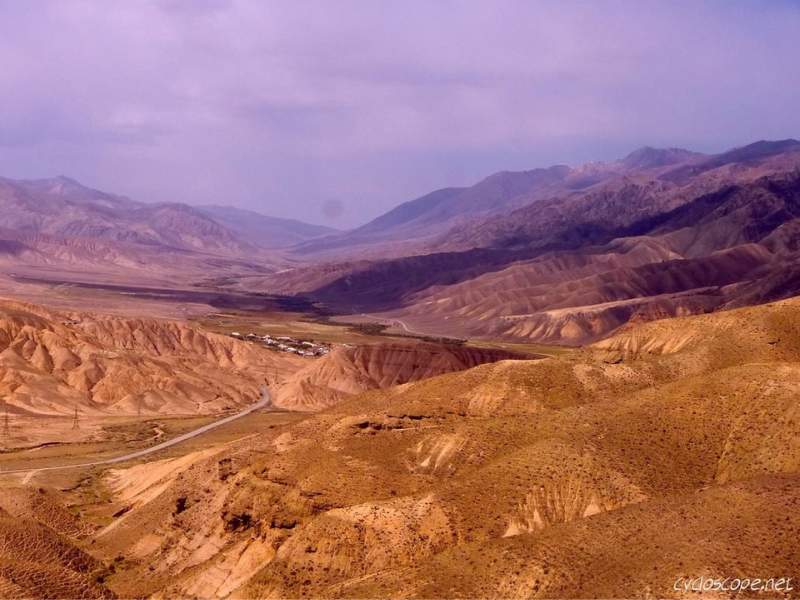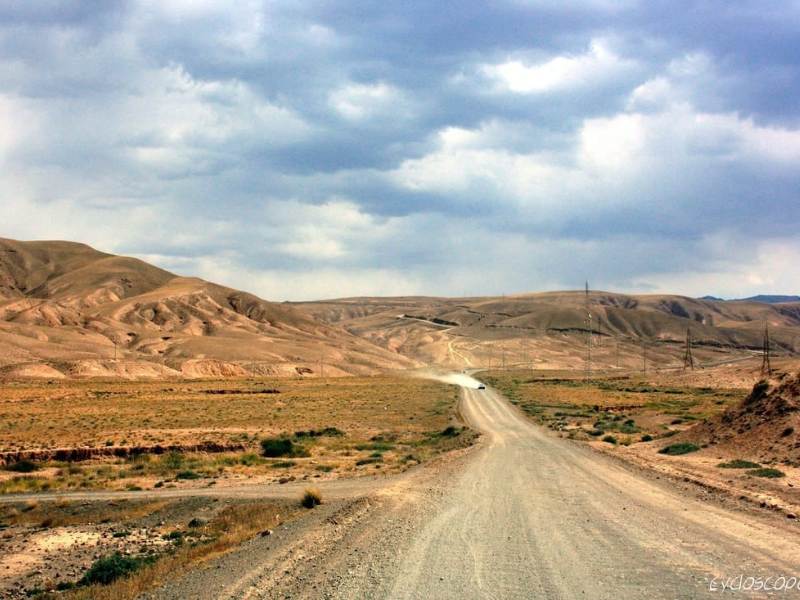Last Updated on 11 June 2024 by Cycloscope

Silk Road travel, bicycle touring up to Song Kul, a big alpine lake 3.000msl in Kyrgyzstan, a road trip. Here the nomads set up their yurt camp (jailoo) in summer.
Bicycle touring Kyrgyzstan has been magnificent so far, the round trip of the Issyk Kul was stunning and the World Nomad Games have been a great experience. Now it’s time for something a bit tougher, we’re going to climb to the highest point of Kyrgyzstan so far.
Song Kul is an alpine lake situated at 3000msl, in the province of Naryn. It’s used, probably for millennia, as a summer jailoo, a yurt camp where nomads bring their herds to fat. To get there we must ride our bikes over a 3,400 meters pass.
How we got from Issyk Kul Lake to Song Kul Lake
We leave our beloved lake Issyk Kul, and cross Balykchy, a “charming” village, once a Soviet tourist destination (is that what they say?), now abandoned to itself.
We cross Balykchy, a “pleasant” little town, once a tourist destination for the Soviet proletariat, now left to itself. Truly an ugly place but somehow fascinating, at least if you like the genre. We note that there are a lot of drunk people, and it’s just 2 PM. Living here must be pretty bleak. We ride again along our dear Chui river and stop to camp in a nice small field on its shore, under a large olive tree.

Tomorrow we’ll start the climb to Song Kul Lake, we arrive in Kochkor, the last “urban” place before heading to the lake.
We enter into one of the many tourist offices to ask if there are still yurts up at the lake. Given the altitude (3000msl) evening will be cold and you better have a B plan in case the tent is not enough (our tent is not a proper winter one).
We are told that the yurts, in the Kyrgyz language Boz Uy, which means gray house (from the color of the felt that covers them), are still there, even though the season is almost over. Most of the Kyrgyz nomad shepherds are indeed semi-nomads, living in the yurts only during summer, when they go graze their herds up in the high mountain pastures, where the grass is nourishing.
The sheep are brought on trucks while the horses go abreast, transhumance could take days, and if on the way back something goes wrong, for example, a snowstorm, they can lose the work of the entire season, the animals can lose the fat or even die. So to come down at the right time is a must.
Even so, some shepherds dare to risk that, staying longer in the Jailoo (the yurt camp), hoping to make some extra bucks from the tourists coming there. It’s a big gamble, but those can be good money for a Kyrgyz nomad family. This is an example of how complex sustainable tourism can be.
The road to Song Kul

Keep going, always uphill, but never too steep. We arrive at the village of Sary Bulak, turn right, and within a few kilometers, we reach the fork for the lake and also the last village where to make supplies.
The sign says Song Kul 50 kilometers. Asphalt nietu. The beginning is vertical and we must necessarily push the bikes. Besides, the road soon becomes a washboard. It is a dirty stony road composed of many small waves, it’s like driving a jackhammer. The bikes are suffering, and we are as well. We rode our touring bikes but were not very suited to this type of road, if we had had an MTB (as we decided to do during our trip to the Himalayas) we would have had very few problems and it could even be a fun road.
We spend more time pushing the bike than trying to pedal, even when the road is flat. The consolation comes when looking at the scenery, but not for long.

We arrive at 2500 meters and a downhill begins, not even time to say “fortunately” and we realize that this is hell. Keeping our bikes straight is very difficult, much worse than the climb, as you go faster. At the end of the descent, there’s a paved road leading to the village. Hooray, let’s hope for the best.
There are three magazin but practically they do not sell anything. Candy and cigarettes. We buy bread and water, yesterday we bought some cheese in Kochkor and a few cans of corn.
The asphalt ends just past the village and we’re in hell again. I want to say that the chick at the tourist office had told us that this was a “VERY GOOD ROAD”. We would like to thank them for the call. To our left is the river that runs through the valley, with no lack of camping spots at least. There are houses of shepherds, who live here all year long. Houses made of mud and stray.
Keep going, pushing 80%, and cycling 20%. We want to go call some Chinese workers, in the space of a week there would certainly be a beautiful road here too. On a full day, we were able to do only 20 km on this road. We stopped to sleep along the river, at 2700 meters, and tomorrow we hope to reach the lake.
Struggling the last leg of the road to Song Kul

The night went quiet, we thought we could feel cold but it went well. Outside was around 0°C but our tent behaved well. When we wake up there’s a nice sunny day. At least in this, we are lucky. But the road, if possible, gets worse.
The climb becomes more vertical and is an expanse of stones. We are at 3000 meters, the pass before descending to the lake it’s 3400 and we think we won’t make it in one day.
Song Kul jailoo: finding a yurt to spend the night

Our idea is to go around the lake and then down from the south road. The road that leads to the Song Kul shore is again a dirt road, but a way better one, with no big stones, and no washboard. We see the first yurts. And the lake. The scenery is idyllic, worth the effort, and the blasphemies.
We arrive at the camp after 8 beautiful km, it seems it’s going to rain, so we’ll stop sleeping here. We go to a random yurt just before us. To sleep there they ask us 500 som per person with breakfast. In total about 13 dollars.
To get a yurt with heating and some warm food I would say it’s okay. Dinner is 200 som per head. Our yurt is nice, with many colorful shirdak, there is a sort of heater powered by cow dung, just like in Kinaliq (Azerbaijan).
How to build a yurt in Kyrgyzstan: anatomy of a Boz Uy

It is late September, there are few tourists and this is probably the best time to visit the lake, if you are lucky with the weather.
The yurt is made up of a small wheel-shaped roof (the one depicted in the flag of Kyrgyzstan) into which sticks are inserted. All around the yurt, there is a circular “fence”, also made of wood, where the aforementioned sticks are tied.
Obviously the door. And then you put the felt to cover it all. No metal, just wood, rope, and fabric. There is no floor but large carpets.
A sudden snowstorm spoils our plans

When we woke up we had a breakfast of eggs, jams, bread, and tea. But there is also another nice surprise outside the yurt, it seems that the snowstorm is arriving a day early. It’s freezing. It’s at least 15 degrees cooler than yesterday. And we have a fever.
We convince ourselves that, not knowing what the road is like, there is no point in venturing. If we get caught in the storm it might not be fun. Furthermore, the dirt road with rain, or worse, snow, would become a muddy mess.
We need to find a ride down from there. Luckily a Dragoman truck offers us a lift, together with two elderly Kyrgyz men, to Kochkor.



